Development of a Module for Determining the Size and Volume of Pulmonary Nodules
- Authors: Teplyakova A.R.1
-
Affiliations:
- Obninsk Institute for Nuclear Power Engineering
- Issue: No 1 (2024)
- Pages: 46-55
- Section: Information processing and data analysis
- URL: https://bakhtiniada.ru/2071-8632/article/view/287319
- DOI: https://doi.org/10.14357/20718632240105
- EDN: https://elibrary.ru/EWDLPX
- ID: 287319
Cite item
Abstract
The article describes the development of the software module, which allows determining the size and volume of pulmonary nodules detected during low-dose computed tomography of the chest organs. The main focus of the article is on automatic quantification of nodules in accordance with the guidelines for the management of pulmonary nodules of the British Thoracic Society, the Fleischner Society, the Lung-RADS and European position statement on lung cancer screening. The approach presented is based on classical image processing methods and methods based on the use of neural networks (U-Net architecture). The input data are masks being obtained as a result of segmentation (it can be performed by a radiologist manually, in automatic or semi-automatic mode) of low-dose CT scans. The output data are DICOM image files being obtained from the original low-dose CT slice files by overlaying metadata, pulmonary nodule contours, long and short axes, and their lengths in mm, and a structured report (DICOM SR) containing lung nodule data in an easy-to-read format. An algorithm for calculating the position of the nodules relative to the lungs is also implemented for the possibility of comparing two studies of one patient in order to estimate the volume doubling time of the pulmonary nodules. The module being described is the part of the medical decision support system, that is being developed to solve the problems of reducing the heavy workload of radiologists and improve the accuracy of diagnosis of various diseases through the analysis of medical images.
About the authors
Anastasia R. Teplyakova
Obninsk Institute for Nuclear Power Engineering
Author for correspondence.
Email: anastasija-t23@mail.ru
Lecturer, Postgraduate Student
Russian Federation, ObninskReferences
- Siegel R. L. et al. Cancer statistics. CA: A Cancer Journal for Clinicians. 2023;73(1):17-48. doi: 10.3322/caac.21763.
- Stilidi I. S. et al. The decrease in the incidence of malignant tumors as a consequence of the epidemic of COVID-19. Public Health. 2022;2(1):5-14. (In Russ.). doi: 10.21045/2782-1676-2021-2-1-5-14.
- Fadeeva E. V. Oncological Care During the COVID-19 Pandemic, Sociologicheskaya nauka i social'naya praktika. 2021:9(1):61-73 (in Russ.). doi: 10.19181/snsp.2021.9.1.7874.
- Gombolevskiy V. А. et al. Main achievements of low-dose computed tomography in lung cancer screening. Tuberculosis and lung diseases. 2021. 99(1):61-70 (in Russ.). doi: 10.21292/2075-1230-2021-99-1-61-70.
- Gombolevskiy V. А. et al. Methodological recommendations for lung cancer screening. Seriya "Luchshie praktiki luchevoj i instrumental’noj diagnostiki". 2020, no. 56, 60 p. (in Russ.).
- Lee J. et al. A narrative review of deep learning applications in lung cancer research: from screening to prognostication. Translational Lung Cancer Research. 2022;11(6):12171229. doi: 10.21037/tlcr-21-1012.
- Chassagnon G. et al. Artificial intelligence in lung cancer: current applications and perspectives. Japanese Journal of Radiology. 2023;41(3):235-244. doi: 10.1007/s11604-02201359-x.
- Li R. et al. Deep Learning Applications in Computed Tomography Images for Pulmonary Nodule Detection and Diagnosis: A Review. Diagnostics. 2022;12(2):298. doi: 10.3390/diagnostics12020298.
- Zhou J. Emerging artificial intelligence methods for fighting lung cancer: A survey. Clinical eHealth. 2022;5:19-34. doi: 10.1016/j.ceh.2022.04.001.
- Abrar A., Rajpoot P. "Classification and Detection of Lung Cancer Nodule using Deep Learning of CT Scan Images": A Systematic Review. 2022. Available from: https://assets.researchsquare.com/files/rs-2145172/v1/2a94278ec16b-4346-ae89-3042ca2fb409.pdf?c=1666567759 [Ac-
- cessed 11 September 2023].
- Jassim M. M., Jaber M. M. "Systematic review for lung cancer detection and lung nodule classification: Taxonomy, challenges, and recommendation future works". Journal of Intelligent Systems. 2022;31(1): 944-964. doi: 10.1515/jisys-2022-0062.
- Larici A. R. et al. Lung nodules: size still matters. European Respiratory Journal. 2017;26(146):170025. doi: 10.1183/16000617.0025-2017.
- de Margerie-Mellon C., Heidinger B., Bankier A. 2D or 3D measurements of pulmonary nodules: preliminary answers and more open questions. Journal Of Thoracic Disease. 2018;10(2):547-549. doi: 10.21037/jtd.2018.01.67.
- Gross C. F. et al. Comparability of Pulmonary Nodule Size Measurements among Different Scanners and Protocols Should Diameter Be Favorized over Volume? Diagnostics. 2023;13(4):631. doi: 10.3390/diagnostics13040631.
- Heuvelmans M. A. et al. Disagreement of diameter and volume measurements for pulmonary nodule size estimation in CT lung cancer screening. Thorax. 2018;73(8):779-781. doi: 10.1136/thoraxjnl-2017-210770.
- Heuvelmans M. A., Oudkerk M. Pulmonary nodules measurements in CT lung cancer screening. Journal of Thoracic Disease. 2018;10(Suppl 17):S2100-S2102. doi: 10.21037/jtd.2018.05.166.
- Han D., Heuvelmans M., Oudkerk M. Volume versus diameter assessment of small pulmonary nodules in CT lung cancer screening. Translational Lung Cancer Research. 2017;6(1):52-61. doi: 10.21037/tlcr.2017.01.05
- Yoon S. et al. Volumetric analysis of pulmonary nodules: reducing the discrepancy between the diameter-based volume calculation and voxel-counting method. Quantitative Imaging In Medicine And Surgery. 2021;12(3):1674-1683. doi: 10.21037/qims-21-485.
- Nikolaev A. E. et al. Tactics of management of the pulmonary nodule depending on the clinical situation: methodological recommendations. Seriya "Luchshie praktiki luchevoj i instrumental’noj diagnostiki". 2022, no. 78, 36 p. (in Russ.).
- Armato 3rd S. G. et al. The Lung Image Database Consortium (LIDC) and Image Database Resource Initiative (IDRI): a completed reference database of lung nodules on CT scans. Medical Physics. 2011;38(2):915-31. doi: 10.1118/1.3528204.
- Teplyakova A. R., Kuznetsov A. A. Development of a Module for COVID-19 Diagnostics Based on Computed Tomography Images of the Chest Based on Computer Vision Methods. Information Technologies. 2023:29(4):204-214 (in Russ.). doi: 10.17587/it.29.204-214.
Supplementary files










